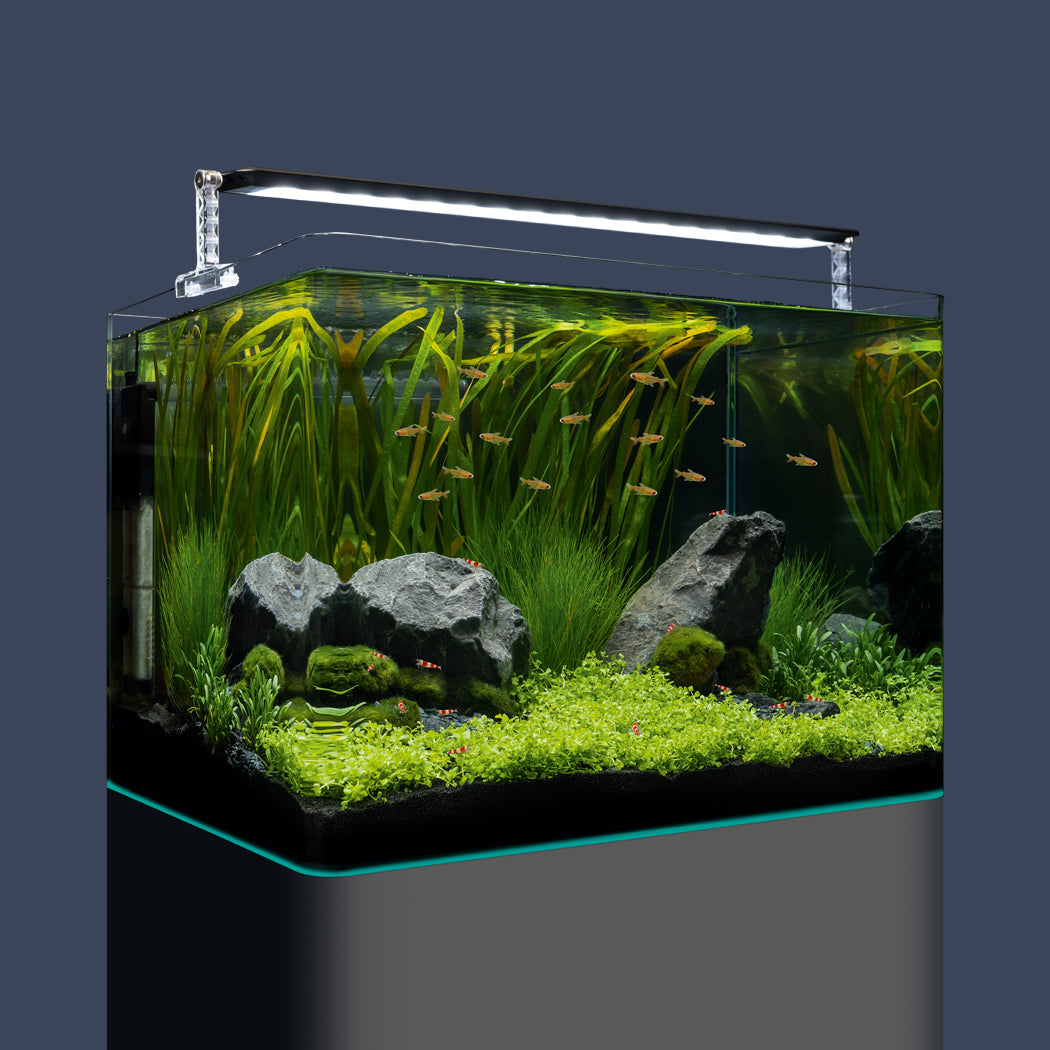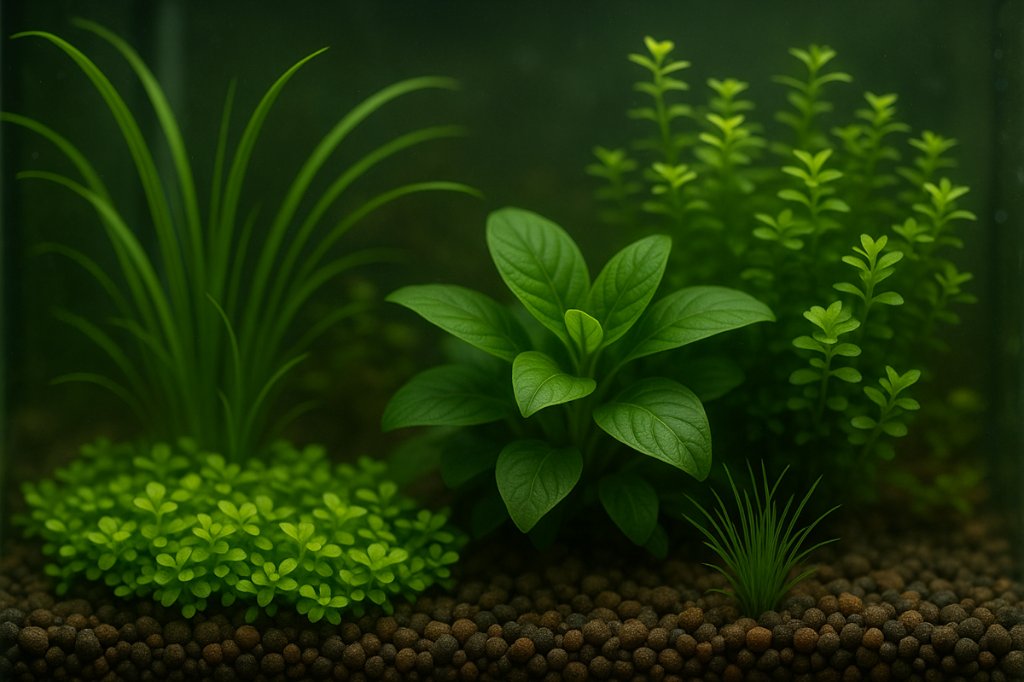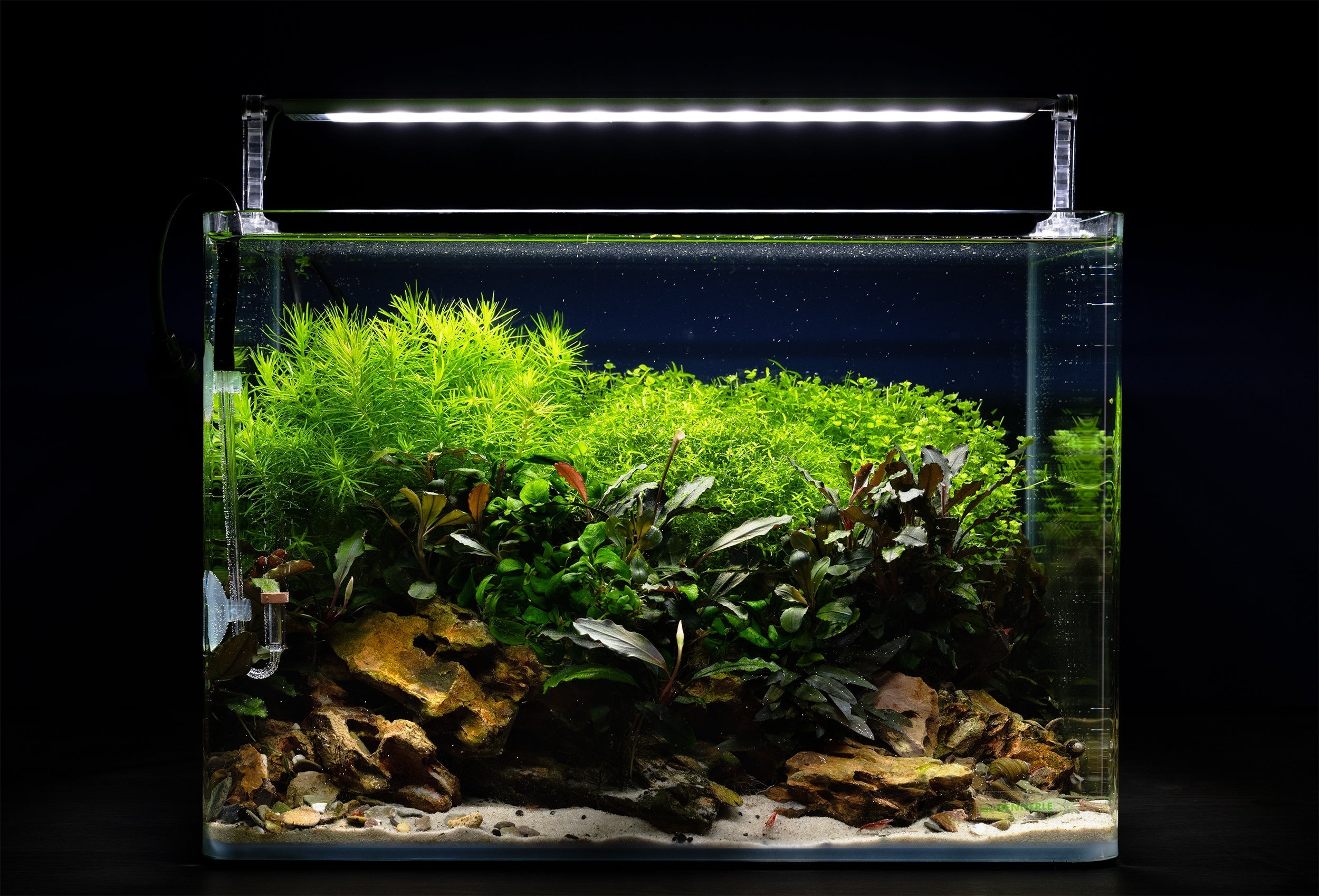Every aquarium has an individual nutrient consumption. That is why the question is often asked: How much fertilizer do I need for my aquarium?
A distinction must be made here between micro nutrient fertilizers (complete iron fertilizers) for planted community aquaria and macro nutrient fertilizers for aquaria without or with a small fish population.
With Dennerle complete iron fertilizers (Plant Elixir Basic, Plant System, Plant Care Pro), simply follow the recommended dosage. With regular use, a nutrient level appropriate for the plants is automatically established. A detrimental overdose of individual nutrients is ruled out.
There is not THE ideal value for every nutrient that is suitable for all plant species. Plants are flexible to a certain extent and have adapted to certain concentration ranges from X to Y mg/L. The aim is therefore to always keep the nutrients in the respective optimum ranges. Dennerle has already taken on this work as part of its fertilizer development.
If in exceptional cases – e.g. with very strong lighting or many fast growing plants - the plants show symptoms of trace element deficiency despite the recommended dosage, the dosage can be gradually increased (e.g. by 10% per week) until the deficiency symptoms have disappeared. The increase should not exceed 50%. At the same time, ensure an adequate supply of macro nutrients and CO2.
If you want to determine the lower limit for the nutrient supply of your aquarium, you can reduce the dosage gradually (e.g. 10% per week) until the first symptoms of deficiency become apparent. Then increase the dosage again by one step to the previous value.
Most trace nutrients cannot be measured using aquarium methods. Iron is an exception. This element plays a special role in plant metabolism and can serve as a so-called guide element. If you want to check your trace nutrient level, you can do this using iron (tests available from specialist retailers).
If the iron is in the optimum range, you can assume that all other trace nutrients are also in the optimum range when using a biologically balanced, high-quality fertilizer. We recommend an iron concentration of 0.05 – 0.2 mg/L.
It should be noted that iron is usually chelated, i.e. surrounded by a protective coating. This protective shell is chemically difficult to crack. Many commercially available iron tests therefore show significantly less iron than is actually present in the water.
The macro nutrients nitrate, phosphate and potassium can all be measured well with aquarium tests. Levels that are too low can be increased with Dennerle Plant Care NPK or the Plant Care N, P and K single fertilizers. Nitrate and phosphate levels that are too high can be reduced with special filter materials.
We generally recommend needs-based fertilization, i.e. only as many nutrients are added as are actually consumed in the period in question. This has proven itself over many years of practice and is the most economical way of fertilizing. It also minimizes the risk of excessive algae growth.
For the sake of completeness, it should be mentioned that there are also other fertilization philosophies today, such as the “Estimative Index”. Here, nutrients are always added in significant excess. Adverse nutrient enrichment is avoided by regular, large partial water changes. However, this method is not entirely uncritical and is only suitable for experienced specialists.
Changes to the plant population or growing conditions also change the nutrient requirements. If you add more and/or more fast-growing plants or increase the light intensity (e.g. by adding a new light), the nutrient consumption will also increase. If you replace fast-growing stem plants with slow-growing plants, cut back the plants or reduce the light intensity, the nutrient requirement will decrease. In the case of minor changes, the usual fertilizer dosage can be maintained. For larger changes, however, the nutrient supply should be adjusted accordingly.
For beginners, it is initially easier to rely on measured values. The more experience you gain, the better you can “read” your aquarium. What do the plants look like? How is the growth? Are there any deficiency symptoms? Is there algae growth? What is the overall impression of the aquarium? Experienced aquarists can usually do without measurements and dose the fertilizer “by feel”.
Tip for newly set up aquariums: Newly introduced plants need a few days to adjust to the new conditions in the aquarium. They grow slowly at first, as they first need to form fresh roots and adjust their metabolism. Most aquarium plants are swamp plants and are therefore grown emersed (above water). Only in the aquarium do they develop underwater leaves, which have a completely different structure. This also takes time. In addition, the plants still have nutrient reserves from the greenhouse. For this reason, they should not be fertilized in the first week and only half the dose recommended on the packet in the second week.
Phosphate-limited fertilization
The macro nutrient phosphate is of particular importance in the aquarium.
It is considered to have a strong algae-promoting effect. However, an increased phosphate content of several mg/L does not necessarily lead to algae problems. A direct correlation has not been scientifically proven. We have also maintained laboratory aquaria with phosphate levels of 5 – 6 mg/L – with magnificent plant growth, but without any algae problems.
Phosphate is always in short supply in the wild. Plants have therefore developed highly effective enrichment mechanisms in the course of evolution. They can absorb even the smallest amounts of phosphate from the water. They are also excellent at storing phosphate in their plant mass - more and better than the small, delicate algae.
The phosphate concentration in clean, unpolluted waters is below 0.01 – 0.03 mg/L. At this level, phosphate becomes the limiting factor for algae growth. This means that even if all other algae nutrients are otherwise available in sufficient quantities, algae can no longer multiply en masse.
Phosphate is a real growth engine, both for aquatic plants and for algae. Phosphate can therefore be used to control both plant growth and algae growth. The recommended concentration for planted aquaria is in the range of 0.1 – 0.3 mg/L (max. 1 mg/L). Higher concentrations are rarely necessary.
If you have a well-planted aquarium with good growing conditions, but which is nevertheless prone to excessive algae growth, you can make life difficult for the algae with phosphate-limited fertilization. The prerequisite for this is that the plants consume more phosphate than is introduced by feeding the animals. In this respect, the method is particularly suitable for aquaria without or with a low fish population.
Proceed as follows:
- Measure the phosphate content
- If the phosphate content is at 0 mg/L for a few days, add 0.1 – 0.2 mg/L phosphate (with Dennerle Plant Care NPK or Plant Care P). The phosphate is normally absorbed quickly.
- When the phosphate content has dropped back to 0 mg/L, wait a few days again. While the plants feed from their internal phosphate stores during the “phosphate-poor times” and continue to grow, the algae “starve” and are thus significantly slowed down in their growth.
- Then 0.1 – 0.2 mg/L phosphate is added again, and so on.
With this method, the plants always get enough phosphate for healthy growth, but the algae disappear over time.
If the plants show symptoms of deficiency, you need to add more phosphate or add it more often.
In aquaria with fewer plants or a higher fish population, the phosphate content will not naturally drop to 0 mg/L, as phosphate is constantly supplied by the fish food or fish excrement, but the plants consume too little phosphate. Here you can use special phosphate removers (liquid or as filter material) to lower the concentration in a targeted manner or, even better, use more fast-growing aquarium plants.




Share:
Plant care – Part 3 – Nutrient supply
Plant care – Part 5 – For a good plant growth